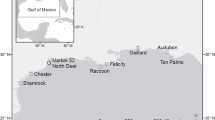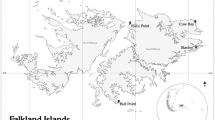Abstract
Mercury (Hg) levels in white stork (Ciconia ciconia) feathers collected in the mid-1990s from five northeastern Mediterranean (Greece) areas varied, with mean ranges between 301 ng g−1 dry weight (dw) (Pinios River) and 1911 ng g−1 dw (Sperchios Delta). A significant increase of Hg levels in chick feathers with age (surrogated by bill size) was found in the Evros and Pinios River areas, a nonsignificant increase in the Amvrakikos Gulf and the Epirus Region, and a marginally significant decrease in the Sperchios Delta area. For combined data of 1993 and 1995, Hg concentrations did not differ significantly in relation to hatching order among broods but differed significantly in relation to brood size being higher in 4-chick broods than those in 3-chick broods. All 10 areas formed 4 groups with levels mutually significantly different. Highest levels were detected in the Evros, Axios, and Sperchios riverine areas, whereas the lowest levels occurred at Drama plain, which lacks large water bodies in its vicinity. Levels were lower than those associated with intoxication to other ciconiiform species.




Similar content being viewed by others
References
Barata C, Fabregat MC, Cotín J, Huertas D, Solé M, Quirós L et al (2010) Blood biomarkers and contaminant levels in feathers and eggs to assess environmental hazards in heron nestlings from impacted sites in Ebro basin (NE Spain). Environ Pollut 158:704–710
Becker PH, Furness RW, Henning D (1993a) The value of chick feathers to assess spatial and interspecific variation in the mercury contamination of seabirds. Environ Monit Assess 28:255–262
Becker PH, Furness RW, Henning D (1993b) Mercury dynamics in young common tern (Sterna hirundo) chicks from a polluted environment. Ecotoxicology 2:33–40
Becker PH, Henning D, Furness RW (1994) Differences in mercury contamination and elimination during feather development in gull and tern broods. Arch Environ Contam Toxicol 27:162–167
Bellos D, Sawidis T (2005) Chemical pollution monitoring of the River Pinios (Thessalia-Greece). J Environ Manage 76:282–292
Bernhard M (1983) Mercury in the Mediterranean. UNEP Regional seas reports and studies, No 98. UNEP
Birdlife International (2004) Birds in Europe: population estimates, trends and conservation status. BirdLife conservation series, no. 12. BirdLife International, Cambridge, p 374
Boncompagni E, Muhammad A, Jabeen R, Orvini E, Gandini C, Sanpera C et al (2003) Egrets as monitors of trace-metal contamination in wetlands of Pakistan. Arch Environ Contam Toxicol 45:399–406
Burger J (1993) Metals in avian feathers: bioindicators of environmental pollution. Rev Environ Toxicol 5:203–311
Burger J, Gochfeld M (1993) Heavy metal and selenium levels in feathers of young egrets and herons from Hong Kong and Szechuan, China. Arch Environ Contam Toxicol 25:322–327
Burger J, Gochfeld M (1997a) Risk, mercury levels, and birds: relating adverse laboratory effects to field biomonitoring. Environ Res 75:160–172
Burger J, Gochfeld M (1997b) Heavy metal and selenium concentrations in feathers of egrets from Bali and Sulawesi, Indonesia. Arch Environ Contam Toxicol 32:217–221
Christoforidis A, Stamatis N, Schmieder K, Tsachalidis E (2008) Organochlorine and mercury contamination in fish tissues from the River Nestos, Greece. Chemosphere 70:694–702
Connell DW, Wong BSF, Lam PKS, Poon KF, Lam MHW, Wu RSS et al (2002) Risk to breeding success of ardeids by contaminants in Hong Kong: evidence from trace metals in feathers. Ecotoxicology 11:49–59
Crawley MJ (1993) GLIM for ecologists. Blackwell Scientific, Oxford
Cristol DA, Brasso RL, Condon AM, Fovargue RE, Friedman SL, Hallinger KK et al (2008) The movement of aquatic mercury through terrestrial food webs. Science 320:335
Custer TW, Golden NH, Rattner BA (2008) Element patterns in feathers of nestling black-crowned night herons, Nycticorax nycticorax L., from four colonies in Delaware, Maryland, and Minnesota. Bull Environ Contam Toxicol 81:147–151
Eisler R (1987) Mercury hazards to fish, wildlife, and invertebrates: a synoptic review. Biological report 85 (1.10). Contaminant Hazard Reviews. Report no. 10, United States Fish and Wildlife Service, p 63
Erkmen B, Kolankaya D (2006) Determination of organochlorine pesticide residues in water, sediment, and fish samples from the Meriç Delta, Turkey. Int J Environ Anal Chem 86:161–169
Fasola M, Movalli PA, Gandini C (1998) Heavy metal, organochlorine pesticide, and PCB residues in eggs and feathers of herons breeding in northern Italy. Arch Environ Contam Toxicol 34:87–93
Ferrara R, Mazzolai B, Lanzillotta E, Nucaro E, Pirrone N (2000) Volcanoes as emission sources of atmospheric mercury in the Mediterranean basin. Sci Total Environ 259:115–121
Fytianos K, Samanidou V, Agelidis T (1986) Comparative study of heavy metals pollution in various rivers and lakes of Northern Greece. Ambio 15:42–44
Gangloff L, Gangloff B, Schmitt B, Schmitt A (1989) Fortpflanzungsprogramm in Gefangenschaft des Weissstorchs im Strassburger Zoo. In: Rheinwald G, Ogden J, Schulz H (eds) White stork. Status and conservation. Proceedings of the first international stork conservation symposium. Walsrode, 14–19 October 1985, Dachverband Deutcher Avifaunisten. Rheinicher Landwirtschafts-Verlag, Bonn, pp 445–460
Gantidis N, Pervolarakis M, Fytianos K (2007) Assessment of the quality characteristics of two lakes (Koronia and Volvi) of N. Greece. Environ Monit Assess 125:175–181
Gariboldi JC, Bryan AL Jr, Jagoe CH (2001) Annual and regional variation in mercury concentrations in wood stork nestlings. Environ Toxicol Chem 20:1551–1556
Golden NH, Rattner BA, McGowan PC, Parsons KC, Ottinger MA (2003) Concentrations of metals in feathers and blood of nestling black-crowned night herons (Nycticorax nycticorax) in Chesapeake and Delaware Bays. Bull Environ Contam Toxicol 70:385–393
Goutner V, Furness RW (1997) Mercury in feathers of little egret Egretta garzetta and night heron Nycticorax nycticorax chicks and in their prey in the Axios Delta, Greece. Arch Environ Contam Toxicol 32:211–216
Goutner V, Furness RW (1998) Feathers of white stork Ciconia ciconia chicks in North-Eastern Greece, as indicators of geographical variation in mercury contamination. Toxicol Environ Chem 67:379–390
Goutner V, Tsachalidis EP (2007) Brood size of the white stork in Greece. Waterbirds 30:152–157
Goutner V, Furness RW, Papakostas G (2001) Mercury in feathers of Squacco Heron (Ardeola ralloides) chicks in relation to age, hatching order, growth and sampling dates. Environ Pollut 111:107–115
Haidouti C, Skarlou V, Tsouloucha F (1985) Mercury contents of some Greek soils. Geoderma 35:251–256
Hancock JA, Kushlan JA, Kahl MP (1992) Storks, ibises and spoonbills of the world. Academic Press, London
Heinz GH, Hoffman DJ, Klimstra JD, Stebbins KR, Kondrad SL, Erwin CA (2009) Species differences in the sensitivity of avian embryos to methylmercury. Arch Environ Contam Toxicol 56:129–138
Henny CJ, Hill EF, Hoffman DJ, Spalding MG, Grove RA (2002) Nineteenth century mercury: hazard to wading birds and cormorants of the Carson River, Nevada. Ecotoxicology 11:213–231
Herring G, Gawlik DE, Rumbold DG (2009) Feather mercury concentrations and physiological condition of great egret and white ibis nestlings in the Florida Everglades. Sci Total Environ 407:2641–2649
Hollamby S, Afema-Azikuru J, Sikarskie JG, Kaneene JB, Bowerman WW, Fitzgerald SD et al (2004) Mercury and persistent organic pollutant concentrations in African fish eagles, marabou storks, and Nile tilapia in Uganda. J Wildl Dis 40:501–514
Honda K, Yoon Min B, Tatsukawa R (1986) Distribution of heavy metals and their age-related changes in the eastern great white egret, Egretta alba modesta, in Korea. Arch Environ Contam Toxicol 15:185–197
Kania W (1988) Investigations of White Stork (Ciconia ciconia) hatching phenology based on bill measurements of nestlings. Ring 12:13–19
Karamanis D, Stamoulis K, Ioannides K, Patiris D (2008) Spatial and seasonal trends of natural radioactivity and heavy metals in river waters of Epirus, Macedonia and Thessalia. Desalination 224:250–260
Konstantinou IK, Hela DG, Albanis TA (2006) The status of pesticide pollution in surface waters (rivers and lakes) of Greece. Part I. Review on occurrence and levels. Environ Pollut 141:555–570
Lewis SA, Furness RW (1991) Mercury accumulation and excretion in laboratory reared black-headed gull Larus ridibundus chicks. Arch Environ Contam Toxicol 21:316–320
Lewis SA, Becker PH, Furness RW (1993) Mercury levels in eggs, tissues, and feathers of herring gulls Larus argentatus from the German Wadden Sea coast. Environ Pollut 80:293–299
Maggi C, Berducci MT, Bianchi J, Giani M, Campanella L (2009) Methylmercury determination in marine sediment and organisms by direct mercury analyser. Anal Chim Acta 641:32–36
Mendrinos D, Choropanitis I, Polyzou O, Karytsas C (2010) Exploring for geothermal resources in Greece. Geothermics 39:124–137
Milovanovic M (2007) Water quality assessment and determination of pollution sources along the Axios/Vardar River, Southeastern Europe. Desalination 213:159–173
Monteiro LR, Furness RW (1995) Seabirds as monitors of mercury in the marine environment. Water Air Soil Pollut 80:851–870
Monteiro LR, Furness RW, del Nevo AJ (1995) Mercury levels in seabirds from the Azores, mid-north Atlantic Ocean. Arch Environ Contam Toxicol 28:304–309
Pacyna EG, Pacyna JM, Pirrone N (2001) European emissions of atmospheric mercury from anthropogenic sources in 1995. Atmos Environ 35:2987–2996
Pacyna EG, Pacyna JM, Steenhuisen F, Wilson S (2006) Global anthropogenic mercury emission inventory for 2000. Atmos Environ 40:4048–4063
Padula V, Burger J, Newman SH, Elbin S, Jeitner C (2010) Metals in feathers of black-crowned night heron (Nycticorax nycticorax) chicks from the New York Harbor Estuary. Arch Environ Contam Toxicol 59:157–165
Pirrone N, Ferrara R, Hedgecock IM, Kallos G, Mamane Y, Munthe J et al (2003) Dynamic processes of mercury over the Mediterranean region: Results from the Mediterranean Atmospheric Mercury Cycle System (MAMCS) project. Atmos Environ 37(Suppl 1):21–39
Roy NK, Bose SS (2008) Determination of mercury in thirty-three international stream sediment and soil reference samples by direct mercury analyser. Geostand Geoanalyt Res 32:331–335
Rumbold DG, Niemczyk SL, Fink LE, Chandrasekhar T, Harkanson B, Laine KA (2001) Mercury in eggs and feathers of Great Egrets (Ardea albus) from Florida Everglades. Arch Environ Contam Toxicol 41:501–507
Sasvári L, Hegyi Z (2001) Condition-dependent parental effort and reproductive performance in the white stork Ciconia ciconia. Ardea 89:281–291
Scheuhammer AM, Meyer MW, Sandheinrich MB, Murray MW (2007) Effects of environmental methylmercury on the health of wild birds, mammals, and fish. Ambio 36:12–18
Skoulikidis NT (2009) The environmental state of rivers in the Balkans—a review within the DPSIR framework. Sci Total Environ 407:2501–2516
Stewart FM, Phillips RA, Catry P, Furness RW (1997) Influence of species, age and diet on mercury concentrations in Shetland seabirds. Mar Ecol Prog Ser 151:237–244
Swain EB, Jakus PM, Rice G, Lupi F, Maxson PA, Pacyna JM et al (2007) Socioeconomic consequences of mercury use and pollution. Ambio 36:45–61
Tavares PC, Monteiro LR, Lopes RJ, Pereira ME, Duarte AC, Furness RW (2005) Variation of mercury contamination in chicks of little tern Sterna albifrons in southwest Europe: brood, age, and colony related effects. Bull Environ Contam Toxicol 74:177–183
Thompson DR, Furness RW (1989) Comparison of the levels of total and organic mercury in seabird feathers. Mar Pollut Bull 20:577–579
Thompson DR, Becker PH, Furness RW (1993) Long-term changes in mercury concentrations in herring gulls Larus argentatus and common terns Sterna hirundo from the German North Sea coast. J Appl Ecol 30:316–320
Tsachalidis EP, Goutner V (2002) Diet of the white stork in Greece in relation to habitat. Waterbirds 25:417–423
Tsachalidis E, Papageorgiou N (1996) Distribution status and breeding of the White Stork Ciconia ciconia in Greece. Avocetta 20:101–106
Tsachalidis EP, Liordos V, Goutner V (2005) Growth of White Stork Ciconia ciconia nestlings. Ardea 93:133–137
Zar JH (1999) Biostatistical analysis, 4th edn. Prentice Hall, Upper Saddle River
Zolfaghari G, Esmaili-Sari A, Ghasempouri SM, Baydokhti RR, Kiabi BH (2009) A multispecies-monitoring study about bioaccumulation of mercury in Iranian birds (Khuzestan to Persian Gulf): effect of taxonomic affiliation and trophic level. Environ Res 109:830–836
Acknowledgments
We are grateful to the Hellenic Public Power Corporation for providing us with technical facilities in the study areas. We are also indebted to U. Pijanowska (ICBM-Terramare) for laboratory technical support. Fieldwork for this project was funded by a grant from the Technological Education Institute. During laboratory analyses, V. Goutner was supported by a sabbatical from the University of Thessaloniki.
Author information
Authors and Affiliations
Corresponding author
Rights and permissions
About this article
Cite this article
Goutner, V., Becker, P.H., Liordos, V. et al. Mercury in White Stork (Ciconia ciconia) Chick Feathers from Northeastern Mediterranean Areas in Relation to Age, Brood Size, and Hatching Order. Arch Environ Contam Toxicol 61, 327–336 (2011). https://doi.org/10.1007/s00244-010-9606-2
Received:
Accepted:
Published:
Issue Date:
DOI: https://doi.org/10.1007/s00244-010-9606-2




